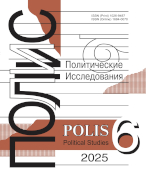“Sanctions for Sanctions Violation”:
U.S. Department of Treasury Enforcement Actions against Financial Sector
Timofeev I.N.,
MGIMO University, Moscow, Russia; Russian International Affairs Council, Moscow, Russia , itimofeev@russiancouncil.ru
elibrary_id: 236879 | ORCID: 0000-0003-1676-2221 |
DOI: 10.17976/jpps/2020.06.06
Timofeev I.N. “Sanctions for Sanctions Violation”: U.S. Department of Treasury Enforcement Actions against Financial Sector. – Polis. Political Studies. 2020. No. 6. https://doi.org/10.17976/jpps/2020.06.06
The author is sincerely grateful to Dmitriy V. Kiku – Deputy Director of the Department for External Restrictions Control of the Russian Ministry of Finance – for his comments on the draft of the article.
Both Russian and foreign researchers have done much to study U.S. sanctions policy. Many focus on “initiator-target” relations, i.e. on state vs. state dyads. However, the U.S. government runs a proactive policy to enforce compliance from both business at home and abroad with the U.S. sanctions regimes. Literature often omits this state vs. business relationship, although business behavior may be crucial to promote or block the isolation of target-states. For business itself, sanctions pose a considerable political risk, fraught with material and reputational loses; the financial sector is under special risk. The article studies the U.S. Department of Treasury’s enforcement actions against financial companies. It raises the following questions: Why is the financial sector the most vulnerable to enforcement? What is the nature of risk for these companies – is it a result of the “special approach” of the government, or a consequence of structural features of the financial sector itself? Why do financial companies violate sanctions regimes? What are the strategies these companies have to deal with the U.S. government and to manage the risk? The research tests three hypotheses. (1) The financial sector suffers due to structural reasons; (2) Companies violate sanctions regimes due to reckless, rather than willful behavior; (3) They prefer to cooperate with the government and improve compliance rather than further conceal violations and repeat them. This rather shows how efficient the U.S. enforcement actions are at changing the behavior of business in financial sector. Testing these assumptions implies analysing 54 cases of enforcement actions against financial companies in 2009-2020, in comparison with a wider sample of 215 cases of other sectors of economy.
References
Ananyev B. 2019. Sanctions in IR: Understanding, Defining, Studying. – International Organisations Research Journal. Vol. 14. No. 3. P. 136-150. https://doi.org/10.17323/1996-7845-2019-03-07
Anglin V. 2016. Why Smart Sanctions Need a Smarter Enforcement Mechanism: Evaluating Recent Settlements Imposed on Sanction-Skirting Banks. – Georgetown Law Journal. Vol. 104. No. 3. P. 693-724.
Bamberger K. 2010. Technologies and Compliance: Risk and Regulation in a Digital Age. – Texas Law Review. Vol. 88. No. 4. P. 669-739.
Bapat N.A., Heinrich T., Kobayashi Y., Morgan T. 2013. Determinants of Sanctions Effectiveness: Sensitivity Analysis Using New Data. – International Interactions. Vol. 39. No. 1. P. 79-98. https://doi.org/10.1080/03050629.2013.751298
Brzoska M. 2015. International Sanctions Before and Beyond UN Sanctions. – International Affairs. Vol. 91. No. 6. P. 1339-1349. https://doi.org/10.1111/1468-2346.12449
Caiazza S., Cotugno M., Fiordelisi F., Stefanelli V. 2018. The Spillover Effect of Enforcement Actions on Bank Risk-Taking. – Journal of Banking and Finance. Vol. 91. P. 146-159. https://doi.org/10.1016/j.jbankfin.2018.04.008
Delis M., Staikouras P. 2011. Supervisory Effectiveness and Bank Risk. – Review of Finance. Vol. 15. No. 3. P. 511-543. https://doi.org/10.1093/rof/rfq035
Drezner D. 1999. The Sanctions Paradox: Economic Statecraft and International Relations. New York: Cambridge University Press. https://doi.org/10.1017/CBO9780511549366
Drezner D. 2015. Targeted Sanctions in a World of Global Finance. – International Interactions. Vol. 41. No. 4. P. 755-764. https://doi.org/10.1080/03050629.2015.1041297
Early B., Preble K. 2018. Enforcing Economic Sanctions: Analyzing How OFAC Punishes Violators of U.S. Sanctions. http://dx.doi.org/10.2139/ssrn.3306653
Evans J. 2010. Sanctions Screening: The Quest for Efficiency and Effectiveness. – Journal of Operational Risk. Vol. 5. No. 3. P. 29-36. https://doi.org/10.21314/JOP.2010.080
Gabbi G., Tanzi P.M., Nadotti L. 2011. Firms Size and Compliance Costs Asymmetries in the Investment Services. – Journal of Financial Regulation and Compliance. Vol. 19. No. 1. P. 58-74. https://doi.org/10.1108/13581981111106176
Geranmayeh E., Rapnouil M.L. 2019. Meeting the Challenge of Secondary Sanctions. – European Council on Foreign Relations Policy Brief. No. 289. URL: https://www.ecfr.eu/publications/summary/meeting_the_challenge_of_secondary_sanctions (accessed 20.09.2020).
Giumelli F. 2016. The Purposes of Targeted Sanctions. – Targeted Sanctions. The Impacts and Effectiveness of United Nations Action. Ed. by T. Beirsteker, S. Eckert, M. Tourihno. New York: Cambridge University Press. P. 38-59. https://doi.org/10.1017/CBO9781316460290.003
Goede M. de, Sullivan G. 2016. The Politics of Security Risks. – Environment and Planning D: Society and Space. Vol. 34. No. 1. P. 67-88. https://doi.org/10.1177/0263775815599309
Gordon J. 2019. The Not So Targeted Instrument of Asset Freezes. – Ethics and International Affairs. Vol. 33. No. 3. P. 303-314. https://doi.org/10.1017/S0892679419000315
Graaf T. van de. 2013. The “Oil Weapon” Reversed? Sanctions Against Iran and U.S.-EU Structural Power. – Middle East Policy. Vol. 20. No. 3. P. 145-163. https://doi.org/10.1111/mepo.12040
Guerello C., Mure P, Rovo N., Spallone M. 2019. On the Informative Content of Sanctions. – The North American Journal of Economics and Finance. Vol. 48. P. 591-612. https://doi.org/10.1016/j.najef.2018.07.013
Hardouin P. 2017. Too Big to Fail, Too Big to Jail: Restoring Liability a Lesson from HSBC Case. – Journal of Financial Crime. Vol. 24. No. 4. P. 513-519. https://doi.org/10.1108/JFC-09-2016-0061
Hatipoglu E., Peksen D. 2018. Economic Sanctions and Banking Crises in Target Economies. – Defense and Peace Economics. Vol. 29. No. 2. P. 171-189. https://doi.org/10.1080/10242694.2016.1245811
Hufbauer G., Shott J., Elliott K., Oegg B. 2009. Economic Sanctions Reconsidered. Third Edition. Washington, DC: Peterson Institute for International Economics.
Hundt S., Horsch A. 2018. The Effects of Sanctions on the Lending Policy and the Value on International Banks: The Case of Iran. – Review of Middle East Economics and Finance. Vol. 14. No. 3. P. 1-13. https://doi.org/10.1515/rmeef-2018-0010
Kline J. 1999. Continuing Controversies Over State and Local Foreign Policy Sanctions in the United States. – The Journal of Federalism. Vol. 29. No. 2. P. 111-134.
Lee J., Doddy J. 2011. Office of Foreign Assets Control Compliance: Recent Developments. – Banking Law Journal. Vol. 128. No. 10. P. 954-959.
Likhacheva A. 2019. Unilateral Sanctions in a Multipolar World. Challenges and Opportunities for Russia’s Strategy. – Russia in Global Affairs. Vol. 17. No. 3. P. 109-131. https://doi.org/10.31278/1810-6374-2019-17-3-109-131
Maloney S. 2015. Sanctions and the Iranian Nuclear Deal: Silver Bullet or Blunt Object? – Social Research. Vol. 82. No. 4. P. 887-911.
Morgan T., Bapat N., Kobayashi Y. 2014. Threat of Imposition of Sanctions: Updating the TIES Dataset. – Conflict Management and Peace Science. Vol. 31. No. 5. P. 541-558.
Nephew R. 2018. The Art of Sanctions. A View from the Field. New York: Columbia University Press.
Neuenkirch M., Neumeier F. 2015. The Impact of UN and US Economic Sanctions on GDP Growth. – European Journal of Political Economy. Vol. 40. Part A. P. 110-125. https://doi.org/10.1016/j.ejpoleco.2015.09.001
O’Brien J. 2014. Disputatious Allies or Political Rivals? Intergovernmental Relations in Financial Regulation in the Aftermath of the Standard Chartered Settlement. – Law and Financial Markets Review. Vol. 8. No. 1. P. 13-19. https://doi.org/10.5235/17521440.8.1.13
Pape R.A. 1997. Why Economic Sanctions Do Not Work? – International Security. Vol. 22. No. 2. P. 90-136.
Restrepo Amariles D., Winkler M. 2018. U.S. Economic Sanctions and the Corporate Compliance of Foreign Banks. – International Lawyer. Vol. 51. No. 3. P. 497-535.
Rosenzweig K. 2013. Regulation of Foreign Banks Operating in the United States: A State Regulator’s Controversial Pursuit of a London-Based Bank. – Fordham Journal of Corporate & Financial Law. Vol. 18. No. 4. P. 1021-1048. URL: https://ir.lawnet.fordham.edu/jcfl/vol18/iss4/6 (accessed 20.09.2020).
Scott A.B. 2020. OFAC Sanctions Compliance: Insights from Recent Enforcement Actions. – Journal of Financial Compliance. Vol. 3. No. 3. P. 247-254.
Scott B.F. 2019. Halkbank and OFAC: A Sanctions Evasion Case Study. – Journal of Money Laundering Control. Vol. 22. No. 4. P. 734-743. https://doi.org/10.1108/JMLC-12-2018-0074
Servettaz E. 2014. A Sanctions Primer. – World Affairs. Vol. 177. No. 2. P. 82-89.
Targeted Sanctions. The Impacts and Effectiveness of United Nations Action. 2016. Ed. by T. Beirsteker S. Eckert, M. Tourihno. New York: Cambridge University Press. https://doi.org/10.1017/CBO9781316460290
Timofeev I. 2019. Rethinking Sanctions Efficiency. Evidence from 205 Cases of the U.S. Government Enforcement Actions against Business. – Russia in Global Affairs. Vol. 17. No. 3. P. 86-108. https://doi.org/10.31278/1810-6374-2019-17-3-86-108
Walker S. 2017. The Foreign Policy Tool of Sanctions, Conflict and Ensuring Continued Access to Finance. Journal of Financial Crime. Vol. 24. No. 3. P. 480-490. https://doi.org/10.1108/JFC-05-2017-0035
Zarate J. 2013. Treasury Wars. The Unleashing of a New Era of Financial Warfare. New York: Public Affairs.
Afontsev S. 2015. Crisis Management under Economic Sanctions: Mission Impossible? – Voprosy Ekonomiki. No. 4. P. 20-36. (In Russ.) https://doi.org/10.32609/0042-8736-2015-4-20-36
Baluev D. 2014. Economic Sanctions as a Foreign Policy Tool. – International Trends. Vol. 12. No. 3. P. 23-33. (In Russ.) URL: http://intertrends.ru/system/Doc/ArticlePdf/534/Baluev-38.pdf (accessed 20.09.2020).
Bartenev V.I. 2018. Aid Prohibition as a Tool of the U.S. Foreign Policy: De Jure and De Facto. – MGIMO Review of International Relations. No. 6. P. 110-140. (In Russ.) https://doi.org/10.24833/2071-8160-2018-6-63-110-140
Glandin S.V. 2018. Revealing Russia Related Sanctions Regimes Violations: The Role of Internet. – Moscow State University Bulletin. Series 11. Law. No. 6. P. 96-112. (In Russ.)
Glandin S.V. 2018. The Exterritorial Effect of American Sanctions. – Mezhdunarodnoe pravosudie. No. 2. P. 105-122. (In Russ.) https://doi.org/10.21128/2226-2059-2018-2-105-122
Glandin S.V., Kadysheva O.V., Keshner M.V. 2018. Western Sanctions and Russian Business: Compliance in the Era of New Challenges (a review of the round table). – Electronic Supplement to Russian Juridical Journal. No. 3. P. 149-152. (In Russ.) URL: http://electronic.ruzh.org/?q=en/system/files/%D0%93%D0%BB%D0%B0%D0%BD%D0%B4%D0%B8%D0%BD.pdf (accessed 20.09.2020).
Gurvich E., Prilepskiy I. 2016. The Impact of Financial Sanctions on the Russian Economy. – Voprosy Ekonomiki. No. 1. P. 5-35. (In Russ.) https://doi.org/10.32609/0042-8736-2016-1-5-35
Jazairi I. 2015. Doklad Spetsial’nogo dokladchika po voprosu o negativnom vozdeistvii odnostoronnikh prinuditel’nykh mer na osushchestvlenie prav cheloveka [Report of the Special Rapporteur on the Negative Impact of Unilateral Coercive Measures on the Enjoyment of Human Rights]. – Sovet po pravam cheloveka. Tridtsataya sessiya [United Nations General Assembly Human Rights Council. Thirty Session]. P. 1-24. (In Russ.) URL: https://www.refworld.org.ru/pdfid/565ff2fe4.pdf (accessed 20.09.2020).
Kuznetsova O. 2016. Foreign Direct Investments in Russian Provinces Under Economic Sanctions. – International Trends. Vol. 14. No. 3. P. 132-142. (In Russ.) https://doi.org/10.17994/IT.2016.14.3.46.9
Panova G.S. 2016. Banks and Banking Business in Russia in the Face of International Sanctions. – MGIMO Review of International Relations. No. 1. P. 154-168. (In Russ.) URL: https://vestnik.mgimo.ru/jour/article/download/496/496 (accessed 20.09.2020).
Shakirov A.R. 2011. U.S. Economic Sanctions: Current State of Affairs and Prospects for the Future. – MGIMO Review of International Relations. No. 1. P. 190-200. (In Russ.)
Simonov V. 2015. Anti-Russian Sanctions and the Systemic Crisis of the World Economy. – Voprosy Ekonomiki. No. 2. P. 49-68. (In Russ.) https://doi.org/10.32609/0042-8736-2015-2-49-68
Timofeev I. 2020. European Paradox: U.S. Sanctions against European Business. – Contemporary Europe. No. 2. P. 45-55. (In Russ.)
Vaslavskiy Y.I., Ananyev B.I. 2018. Mezhdunarodnye ekonomicheskie sanktsii: teoreticheskii rakurs [International Economic Sanctions: Theoretical View]. – Politika razvitiya, gosudarstvo i mirovoi poryadok. Materialy VIII Vserossiiskogo kongressa politologov [Development Issues, State and the International Order. Papers of the VIII All-Russia Congress of Political Science]. Ed. by O.V. Gaman-Golutvina, L.V. Smorgunov, L.N. Timofeeva. Moscow: Aspect Press. P. 104-105. (In Russ.)
See also:
Korgun I.A., Toloraya G.D.,
On the question of effectiveness of sanctions against DPRK. – Polis. Political Studies. 2022. No3
Timofeev I.N.,
The U.S. Sanctions Against Iran: Experience and Eventual Implications. – Polis. Political Studies. 2018. No4
Timofeev I.N.,
Policy of sanctions in a changing world: theoretical reflection. – Polis. Political Studies. 2023. No2
Arapova E.Ya., Kudinov A.S.,
International sanctions legislation in the U.S., EU and UK: a comparative study. – Polis. Political Studies. 2022. No6
Sokolshchik L.M., Sokolshchik Yu.S., Teremetskiy K.S.,
Discursive strategies for legitimizing U.S. sanctions policy towards Russia (2021-2023). – Polis. Political Studies. 2024. No3




.jpg)






 print
print
.jpg)
.jpg)